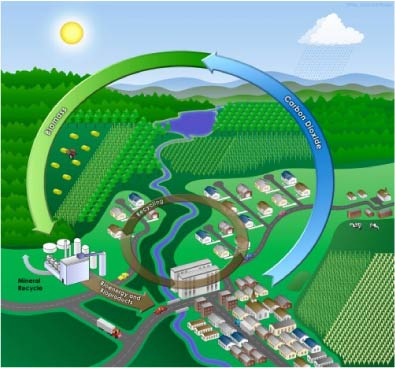 A few weeks ago, I wrote a little about how small leisure-businesses deal with ecological issues, and how that is sometimes stimulated by government-subsidies. In my ignorance, I saw this mostly as a marketing-issue, though an article by Michael Porter and Forest Reinhardt in the October-issue of HBR, made me look at it a little differently. In it, Porter and Reinhardt propose a strategic look at climate issues, both inside-out—pertaining to the company's activities—and outside-in—assessing how external factors can affect the business.
A few weeks ago, I wrote a little about how small leisure-businesses deal with ecological issues, and how that is sometimes stimulated by government-subsidies. In my ignorance, I saw this mostly as a marketing-issue, though an article by Michael Porter and Forest Reinhardt in the October-issue of HBR, made me look at it a little differently. In it, Porter and Reinhardt propose a strategic look at climate issues, both inside-out—pertaining to the company's activities—and outside-in—assessing how external factors can affect the business.
Inside-out
By looking at activities along the value chain of a business—meaning all the activities that affect the final value to the customer—and calculating eco-costs per activity, the company can evaluate what activities cost in terms of total emissions and make a decision as how to deal with them. Note, that both in a strategic and a marketing-sense, both direct and indirect costs are relevant.
Assuming that emission costs are a certain expense in the future, looking at a value chain in this way can have severe consequences on seemingly innovative activities, like just-in-time supply chain management, which is quite transportation-intensive; e-commerce, which often depends on small shipments; and offshoring, which can severely lengthen transportation-routes.
Some examples of how to deal with emissions inside out are:
- Using tools within the enterprise, like Toyota's life-truck, that is designed all around for reduced cost to the environment.
- exchange information with your partners regarding gas emissions, reduction targets, and other climate-change targets.
- Have your own procedures in place to evaluate not only your own emissions, but also those of your suppliers' products coming in and those of your end-products, when used by your customers. This also involves visiting your partners' production-facilities, forming collaborative emission-reducing strategies, and understanding how your customers use and dispose of your end-products.
- Creating an incentive structure with your partners, which involves carbon credit-trading and other rewards for their good behaviour.
- Similarly, set up information-exchange policies on a departmental and business-unit-level regarding emissions and reduction-strategies, and implement a reward-system.
- When on land, using rail-road transportation instead of road, as that is far more efficient in terms of emissions.
- Evaluate your activities, and focus on optimising the high-value ones and either eliminating the low-value ones or outsourcing them to more efficient companies.
- Jeremy Fain, at Tech IT Easy, also proposes some measures on how to implement IT-related cost-reductions
Outside-in
According to the article, there are two external threats to businesses: that of actual climate-change and how that will affect regions that may be important to a firm's bottom-line; and regulations imposed by governments, which may impose costs on certain activities. Both are very hard to deal with.
Obviously, for the latter—the regulations—the best way is to implement as many "inside-out" savings as possible. In addition, it is important to work closely with watchdog-agencies and institutions to be compatible with most recent trends, as well as be prepared for what may come.
For the first—safeguarding against climate-change—only companies that can either keep their supply-chains flexible enough to deal with regional changes, or those that can invest in scientific "cures" for climate-changes, such as drought-resisting crop, can have some sort of advantage in this regard.
Final thoughts
The scientific community is fairly aligned in their perception of the problem. And for the business-world, Porter and Reinhardt see this as a revolutionising force, equalling or outweighing globalisation and information technology.
A lot of business are still receiving mixed messages from the political, scientific, business, and consumer-community. But what is certain is that legislation will continue to become more strict in this regard. So from a cost-perspective, it certainly is a wise choice to implement emission-reducing measures as early and as wide-spread as possible.
Similarly, as I wrote in my last post, there is a public-relations angle. Customers are becoming much more aware of environmental factors, and may prefer to shop at places which respect this reality.
The picture is courtesy of firstnationalpower.com.
Filed under: branding, business strategy, design, eco-trends, Globalisation, green, innovation, operation, Research, retail, suppliers, technology, tools, trends
 A few weeks ago, I wrote a little about how small leisure-businesses deal with ecological issues, and how that is sometimes stimulated by government-subsidies. In my ignorance, I saw this mostly as a marketing-issue, though an article by Michael Porter and Forest Reinhardt in the October-issue of HBR, made me look at it a little differently. In it, Porter and Reinhardt propose a strategic look at climate issues, both inside-out—pertaining to the company's activities—and outside-in—assessing how external factors can affect the business.
A few weeks ago, I wrote a little about how small leisure-businesses deal with ecological issues, and how that is sometimes stimulated by government-subsidies. In my ignorance, I saw this mostly as a marketing-issue, though an article by Michael Porter and Forest Reinhardt in the October-issue of HBR, made me look at it a little differently. In it, Porter and Reinhardt propose a strategic look at climate issues, both inside-out—pertaining to the company's activities—and outside-in—assessing how external factors can affect the business.Inside-out
By looking at activities along the value chain of a business—meaning all the activities that affect the final value to the customer—and calculating eco-costs per activity, the company can evaluate what activities cost in terms of total emissions and make a decision as how to deal with them. Note, that both in a strategic and a marketing-sense, both direct and indirect costs are relevant.
Assuming that emission costs are a certain expense in the future, looking at a value chain in this way can have severe consequences on seemingly innovative activities, like just-in-time supply chain management, which is quite transportation-intensive; e-commerce, which often depends on small shipments; and offshoring, which can severely lengthen transportation-routes.
Some examples of how to deal with emissions inside out are:
- Using tools within the enterprise, like Toyota's life-truck, that is designed all around for reduced cost to the environment.
- exchange information with your partners regarding gas emissions, reduction targets, and other climate-change targets.
- Have your own procedures in place to evaluate not only your own emissions, but also those of your suppliers' products coming in and those of your end-products, when used by your customers. This also involves visiting your partners' production-facilities, forming collaborative emission-reducing strategies, and understanding how your customers use and dispose of your end-products.
- Creating an incentive structure with your partners, which involves carbon credit-trading and other rewards for their good behaviour.
- Similarly, set up information-exchange policies on a departmental and business-unit-level regarding emissions and reduction-strategies, and implement a reward-system.
- When on land, using rail-road transportation instead of road, as that is far more efficient in terms of emissions.
- Evaluate your activities, and focus on optimising the high-value ones and either eliminating the low-value ones or outsourcing them to more efficient companies.
- Jeremy Fain, at Tech IT Easy, also proposes some measures on how to implement IT-related cost-reductions
Outside-in
According to the article, there are two external threats to businesses: that of actual climate-change and how that will affect regions that may be important to a firm's bottom-line; and regulations imposed by governments, which may impose costs on certain activities. Both are very hard to deal with.
Obviously, for the latter—the regulations—the best way is to implement as many "inside-out" savings as possible. In addition, it is important to work closely with watchdog-agencies and institutions to be compatible with most recent trends, as well as be prepared for what may come.
For the first—safeguarding against climate-change—only companies that can either keep their supply-chains flexible enough to deal with regional changes, or those that can invest in scientific "cures" for climate-changes, such as drought-resisting crop, can have some sort of advantage in this regard.
Final thoughts
The scientific community is fairly aligned in their perception of the problem. And for the business-world, Porter and Reinhardt see this as a revolutionising force, equalling or outweighing globalisation and information technology.
A lot of business are still receiving mixed messages from the political, scientific, business, and consumer-community. But what is certain is that legislation will continue to become more strict in this regard. So from a cost-perspective, it certainly is a wise choice to implement emission-reducing measures as early and as wide-spread as possible.
Similarly, as I wrote in my last post, there is a public-relations angle. Customers are becoming much more aware of environmental factors, and may prefer to shop at places which respect this reality.
The picture is courtesy of firstnationalpower.com.
 The
The 

